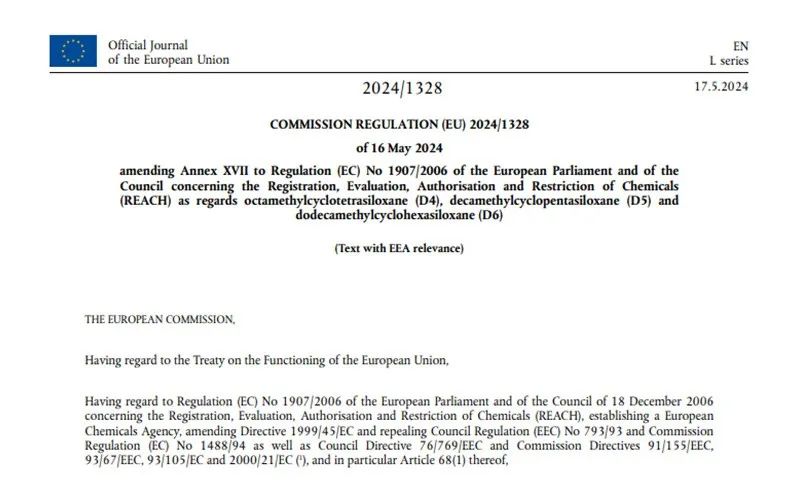Product Compliance
filing/registration/consulting/training


REACH update: Further EU restrictions on
The use of organosilicon D5 and D6 in cosmetics

On 16 May 2024, Commission Regulation (EU) 2024/1328 was published in the Official Journal of the European Union. The new regulation amends the restrictions in REACH for octamethylcyclotetrasiloxane(D4), decamethylcyclopentasiloxane(D5) and dodecamethylcyclohexasiloxane (D6). These restrictions are in addition to the existing restrictions in REACH for D4 and D5 in rinse-off cosmetic products.
This amendment is necessary to address the environmental risks posed by the use of these substances in consumer products, which can eventually be released into aquatic systems and the atmosphere. In addition, the Risk Assessment Committee (RAC) of the European Chemicals Agency has determined that cosmetics are a major source of release of these substances into the environment.
It is important to note that D4 is already included in Annex II of the EU Cosmetics Regulation - a list of substances prohibited in cosmetic products. Therefore, the new restrictions on this substance will not affect existing cosmetic products.

New restrictions for D5 and D6
According to the new REACH amendment, decamethylcyclopentasiloxane (D5) and dodecamethylcyclohexasiloxane (D6) can be used in cosmetics under the following conditions.
Decamethylcyclopentasiloxane (D5):
· From January 31, 2020, the maximum concentration in rinse-off cosmetics is 0.1% (already applicable);
· From June 6, 2027, the maximum concentration in leave-on cosmetics is 0.1%.
Dodecamethylcyclohexasiloxane (D6):
· From June 6, 2027, the maximum concentration in rinse-off and leave-on cosmetics is 0.1%.
The European Commission has given a 3-year transition period for the implementation of the amendment in order to balance two needs: on the one hand, the need to limit emissions in a timely manner; on the other hand, it is necessary to give the industry enough time to comply with the new requirements.
What to do now
As a cosmetics manufacturer or brand owner, you need to verify that your products contain D5 or D6 and comply with the 0.1% concentration limit, or otherwise reformulate, retest and re-notify to the CPNP. In addition, you must ensure that non-compliant products are removed from the EU market by June 6, 2027. Therefore, good supply chain management is essential.
ZOOP’s Services
European Union:
1. Product classification
2. CPNP notifications
3. Formulation audits
4. Audit of labeling and claims
5. Website detail page audit
6. Cosmetic Safety Assessment Report (CPSR)
7. PIF documentation review and organization
8. Representation of responsible persons in the EU